An Analysis of the Spatial Characteristics and Transport Fluxes of BTEX in Soil and Atmospheric Phases at a Decommissioned Steel Mill Site in China with a Long History
Abstract
:1. Introduction
2. Materials and Methods
2.1. Research Areas
2.2. Sample Collection and Methods of Analysis
2.3. Correlation Analysis Method
2.4. Construction of the Fugacity Model
2.5. Human Health Risk Assessment Methods
2.5.1. Soil Pollution Health Risk Assessment Method
2.5.2. Air Pollution Health Risk Assessment Method
3. Results and Discussion
3.1. Spatial Distribution Characteristics of BTEX
3.1.1. Pollution Characteristics and Spatial Distribution of BTEX in Soil
3.1.2. Pollution Characteristics and Spatial Distribution of BTEX in the Air
3.2. Transport Flux of Pollutants in Soil and Air Phases
3.2.1. Correlation Analysis of Soil–Air BTEX
3.2.2. Transport of BTEX between the Soil and Air Phases
3.2.3. Distribution Characteristics of Soil-Air BTEX Transport Flux
3.3. Health Risk Assessment for BTEX
3.3.1. Health Risks of BTEX in the Soil
3.3.2. Health Risks of BTEX in the Air
4. Conclusions and Recommendations
- (1)
- Both soil and air at the study sites show significant benzene pollution. The maximum exceedance factor for benzene in soil samples is 31.5, accounting for 13.04% of the total sampling points, with the highest concentration occurring at the depth of the capillary zone. The maximum concentration of benzene in air samples is 4.98 μg·m−3, which is close to the evaluation standards in Germany, the UK, and the EU, and the probability of exceeding the standard is high among the pollutants of concern.
- (2)
- The correlation analysis of BTEX indicates that o-xylene has the strongest correlation coefficient of −0.839 (p < 0.01), followed by ethylbenzene and benzene, which also show excellent correlation; there is a certain degree of exchange between these three components in the soil–air medium.
- (3)
- The results from the multi-media fugacity model show that 94.1% of sampling points show a trend of transport from the soil phase to the air phase. The average transport flux levels from highest to lowest are benzene (93,786 × 10−7 mol·h−1) > o-xylene (62,786 × 10−7 mol·h−1) > ethylbenzene (16,507 × 10−7 mol·h−1). Benzene is the pollutant that contributes the most to the transport flux from soil to air within the site.
- (4)
- The BTEX in both the soil and air at the study sites can pose health risks to humans. The non-carcinogenic risk values for BTEX in soil are below the acceptable risk level (HQ < 1). The total carcinogenic risk value for benzene in children’s exposure scenarios exceeds the carcinogenic risk level (1 × 10−6), and the proportion of sampling points exceeding the acceptable carcinogenic risk level is 12.5%. The fluctuation range of the hazard index (HI) for BTEX in ambient air is between 2.08 × 10−4 and 1.81 × 10−1, and all sampling points have HI values below the safety threshold of 1. The range of the carcinogenic risk values for BTEX in the air is between 2.63 × 10−6 and 3.88 × 10−5, and all sampling points in the research area have acceptable carcinogenic risks exceeding the threshold of 10−6. Through institutional control, managers can shorten the ET and EF of the population, reduce the exposure concentration, and thus reduce the risk of cancer.
- (5)
- Our proposal aims to decrease the duration and frequency of population exposure by implementing institutional control measures. This approach seeks to lower the concentration of exposure and mitigate the risk of carcinogenesis. In locations designated for coking and sewage treatment, where the potential for benzene accumulation is significant, it is advisable to employ in situ oxidation or in situ thermal desorption techniques for soil remediation, particularly where the intended land use in the future is residential. These methods allow for the treatment of contaminated soil without the need for excavation or disturbance.
Supplementary Materials
Author Contributions
Funding
Institutional Review Board Statement
Data Availability Statement
Conflicts of Interest
References
- Huang, S.; Tan, X.; Zhu, Y. Implementation of a green and sustainable concept to evaluate footprint and optimize contaminated site remediation in china: A case study. Environ. Eng. Sci. 2019, 36, 1269–1280. [Google Scholar] [CrossRef]
- Li, X.; Jiao, W.; Xiao, R.; Chen, W.; Liu, W. Contaminated sites in China: Countermeasures of provincial governments. J. Clean. Prod. 2017, 147, 485–496. [Google Scholar] [CrossRef]
- O’Connor, D.; Müller-Grabherr, D.; Hou, D. Strengthening social-environmental management at contaminated sites to bolster green and sustainable remediation via a survey. Chemosphere 2019, 225, 295–303. [Google Scholar] [CrossRef] [PubMed]
- Bolden, A.L.; Kwiatkowski, C.F.; Colborn, T. New look at btex: Are ambient levels a problem? Environ. Sci. Technol. 2015, 49, 5261–5276. [Google Scholar] [CrossRef]
- IARC. List of Classifications[eb/ol]. Available online: https://monographs.iarc.who.int/list-of-classifications (accessed on 14 October 2023).
- Kanjanasiranont, N.; Prueksasit, T.; Morknoy, D. Inhalation exposure and health risk levels to btex and carbonyl compounds of traffic policeman working in the inner city of Bangkok, Thailand. Atmos. Environ. 2017, 152, 111–120. [Google Scholar] [CrossRef]
- Kitwattanavong, M.; Prueksasit, T.; Morknoy, D.; Tunsaringkarn, T.; Siriwong, W. Health risk assessment of petrol station workers in the inner city of bangkok, thailand, to the exposure to btex and carbonyl compounds by inhalation. Hum. Ecol. Risk Assess. Int. J. 2013, 19, 1424–1439. [Google Scholar] [CrossRef]
- Garg, A.; Gupta, N.C. A comprehensive study on spatio-temporal distribution, health risk assessment and ozone formation potential of btex emissions in ambient air of Delhi, India. Sci. Total Environ. 2019, 659, 1090–1099. [Google Scholar] [CrossRef]
- Miri, M.; Rostami Aghdam Shendi, M.; Ghaffari, H.R.; Ebrahimi Aval, H.; Ahmadi, E.; Taban, E.; Gholizadeh, A.; Yazdani Aval, M.; Mohammadi, A.; Azari, A. Investigation of outdoor btex: Concentration, variations, sources, spatial distribution, and risk assessment. Chemosphere 2016, 163, 601–609. [Google Scholar] [CrossRef] [PubMed]
- Alahabadi, A.; Fazeli, I.; Rakhshani, M.H.; Najafi, M.L.; Alidadi, H.; Miri, M. Spatial distribution and health risk of exposure to btex in urban area: A comparison study of different land-use types and traffic volumes. Environ. Geochem. Health 2021, 43, 2871–2885. [Google Scholar] [CrossRef] [PubMed]
- Wu, S.; Xiang, Z.; Lin, D.; Zhu, L. Multimedia distribution and health risk assessment of typical organic pollutants in a retired industrial park. Front. Environ. Sci. Eng. 2023, 17, 142. [Google Scholar] [CrossRef]
- Wu, M.; Zhao, Z.; Cai, G.; Wang, C.; Cheng, G.; Wang, X. Adsorption behaviour and mechanism of benzene, toluene and m-xylene (btx) solution onto kaolinite: Experimental and molecular dynamics simulation studies. Sep. Purif. Technol. 2022, 291, 120940. [Google Scholar] [CrossRef]
- Shi, J.; Yang, Y.; Li, J.; Xi, B.; Wang, Y.; Wang, Y.; Tang, J. A study of layered-unlayered extraction of benzene in soil by sve. Environ. Pollut. 2020, 263, 114219. [Google Scholar] [CrossRef]
- Ghoshal, S.; Pasion, C.; Alshafie, M. Reduction of benzene and naphthalene mass transfer from crude oils by aging-induced interfacial films. Environ. Sci. Technol. 2004, 38, 2102–2110. [Google Scholar] [CrossRef] [PubMed]
- Teramoto, E.H.; Chang, H.K. Field data and numerical simulation of btex concentration trends under water table fluctuations: Example of a jet fuel-contaminated site in Brazil. J. Contam. Hydrol. 2017, 198, 37–47. [Google Scholar] [CrossRef] [PubMed]
- Yang, S.; Yan, X.; Zhong, L.; Tong, X. Benzene homologues contaminants in a former herbicide factory site: Distribution, attenuation, risk, and remediation implication. Environ. Geochem. Health 2020, 42, 241–253. [Google Scholar] [CrossRef]
- Jia, H.; Gao, S.; Duan, Y.; Fu, Q.; Che, X.; Xu, H.; Wang, Z.; Cheng, J. Investigation of health risk assessment and odor pollution of volatile organic compounds from industrial activities in the yangtze river delta region, China. Ecotoxicol. Environ. Saf. 2020, 208, 111474. [Google Scholar] [CrossRef] [PubMed]
- Han, B.; Chen, J.; Zheng, L.; Zhou, T.; Li, J.; Wang, X.; Wang, J. Development of an impurity-profiling method for source identification of spilled benzene series compounds by gas chromatography with mass spectrometry: Toluene as a case study. J. Sep. Sci. 2015, 38, 3198–3204. [Google Scholar] [CrossRef]
- Hu, H.; Li, T.; Sun, X.; Zhang, X.; Zhang, X.; Zhong, Z.; Guo, Y. Determination of benzene series compounds and chlorobenzenes in water sample by static headspace gas chromatography with flame ionization detection. J. Sep. Sci. 2015, 38, 1916–1923. [Google Scholar] [CrossRef]
- Du, P.; Sagehashi, M.; Terada, A.; Zhou, S.; Li, F.; Hosomi, M. Adequacy of a simple diffusion model to predict benzene behavior in soil. Soil Sci. Soc. Am. J. 2011, 75, 2147–2157. [Google Scholar] [CrossRef]
- Reid, M.C.; Jaffé, P.R. A push–pull test to measure root uptake of volatile chemicals from wetland soils. Environ. Sci. Technol. 2013, 47, 3190–3198. [Google Scholar] [CrossRef]
- Choi, J.; Smith, J.A. Geoenvironmental factors affecting organic vapor advection and diffusion fluxes from the unsaturated zone to the atmosphere under natural conditions. Environ. Eng. Sci. 2005, 22, 95–108. [Google Scholar] [CrossRef]
- Du, P.; Wang, S.J.; Zhao, H.H.; Wu, B.; Han, C.M.; Fang, J.D.; Li, H.Y.; Hosomi, M.; Li, F.S. Factors affecting benzene diffusion from contaminated soils to the atmosphere and flux characteristics. Environ. Sci. 2013, 34, 8. [Google Scholar] [CrossRef]
- Van Leeuwen, C.J.; Vermeire, T.G. Risk Assessment of Chemicals: An Introduction; Springer: Berlin/Heidelberg, Germany, 2007. [Google Scholar] [CrossRef]
- Mackay, D.; Paterson, S. Evaluating the multimedia fate of organic chemicals: A level iii fugacity model. Environ. Sci. Technol. 1991, 25, 427–436. [Google Scholar] [CrossRef]
- Dai, S.G.; Huang, G.L.; Lei, H.X. The multimedia model of tributyltin chloride in a unit world. Toxicol. Environ. Chem. 1995, 49, 61–71. [Google Scholar] [CrossRef]
- Zhang, Q.; Ying, G.; Pan, C.; Liu, Y.; Zhao, J. Comprehensive evaluation of antibiotics emission and fate in the river basins of china: Source analysis, multimedia modeling, and linkage to bacterial resistance. Environ. Sci. Technol. 2015, 49, 6772–6782. [Google Scholar] [CrossRef]
- Klasmeier, J.; Matthies, M.; Macleod, M.; Fenner, K.; Scheringer, M.; Stroebe, M.; Le Gall, A.C.; Mckone, T.; Van De Meent, D.; Wania, F. Application of multimedia models for screening assessment of long-range transport potential and overall persistence. Environ. Sci. Technol. 2006, 40, 53–60. [Google Scholar] [CrossRef]
- Na, H.; Sun, J.; Qiu, Z.; He, J.; Yuan, Y.; Yan, T.; Du, T. A novel evaluation method for energy efficiency of process industry—A case study of typical iron and steel manufacturing process. Energy 2021, 233, 121081. [Google Scholar] [CrossRef]
- HJ 25.2-2019; Technical Guidelines for Monitoring during Risk Control and Remediation of Soil Contamination of Land for Construction. China Environmental Science Press: Beijing, China, 2019. Available online: https://www.mee.gov.cn/ywgz/fgbz/bz/bzwb/trhj/201912/t20191224_749891.shtml (accessed on 1 June 2023).
- HJ 605-2011; Soil and Sediment-Determination of Volatile Organic Compounds-Purge and Trap Gas Chromatography/Mass Spectrometry Method. China Environmental Science Press: Beijing, China, 2011. Available online: https://www.mee.gov.cn/ywgz/fgbz/bz/bzwb/jcffbz/201102/t20110216_200839.shtml (accessed on 1 June 2023).
- HJ 644-2013; Ambient Air-Determination of Volatile Organic Compounds-Sorbent Adsorption and Thermal Desorption/Gas Chromatography Mass Spectrometry Method. China Environmental Science Press: Beijing, China, 2013. Available online: https://www.mee.gov.cn/ywgz/fgbz/bz/bzwb/jcffbz/201302/t20130222_248384.shtml (accessed on 1 June 2023).
- Brandes, L.J.; Den Hollander, H.; Van de Meent, D. Simplebox 2.0: A Nested Multimedia Fate Model for Evaluating the Environmental Fate of Chemicals; National Institute for Public Health and the Environment (RIVM): Bilthoven, The Netherlands, 1996; Available online: http://hdl.handle.net/10029/10407 (accessed on 1 June 2023).
- Diamond, M.L.; Priemer, D.A.; Law, N.L. Developing a multimedia model of chemical dynamics in an urban area. Chemosphere 2001, 44, 1655–1667. [Google Scholar] [CrossRef] [PubMed]
- Linstorm, P. Nist chemistry webbook, nist standard reference database number 69. J. Chem. Eng. Data 1998, 9, 1059–1063. [Google Scholar] [CrossRef]
- Haynes, W.M. CRC Handbook of Chemistry and Physics; CRC Press: Boca Raton, FL, USA, 2014; Available online: https://analysischamp.com/CRCHandbook01.pdf (accessed on 1 June 2023).
- Parnis, J.M.; Mackay, D. Multimedia Environmental Models: The Fugacity Approach; CRC press: Boca Raton, FL, USA, 2020. [Google Scholar] [CrossRef]
- Avigliano, E.; Schenone, N.F. Human health risk assessment and environmental distribution of trace elements, glyphosate, fecal coliform and total coliform in Atlantic rainforest mountain rivers (South America). Microchem. J. 2015, 122, 149–158. [Google Scholar] [CrossRef]
- HJ 25.3-2019; Technical Guidelines for Risk Assessment of Soil Contamination of Land for Construction. China Environmental Science Press: Beijing, China, 2019. Available online: https://www.mee.gov.cn/ywgz/fgbz/bz/bzwb/trhj/201912/t20191224_749893.shtml (accessed on 1 June 2023).
- Council, N.R. Risk Assessment in the Federal Government: Managing the Process; National Academies Press: Washington, DC, USA, 1983. Available online: https://www.ncbi.nlm.nih.gov/books/NBK216741/ (accessed on 1 June 2023).
- Usepa. Integrated Risk Information System. United States. Environmental Protection Agency-Epa. 1999. Available online: https://www.epa.gov/iris (accessed on 1 June 2023).
- Li, L.; Li, H.; Wang, X.Z.; Zhang, X.M.; Wen, C. Pollution characteristics and health risk assessment of atmospheric vocs in the downtown area of Guangzhou, China. Environ. Sci. 2013, 34, 7. Available online: https://europepmc.org/article/med/24640890 (accessed on 1 June 2023).
- Xiao, M. Source Apportionment Based on Pmf Model and Pollution Characteristics of Atmospheric Vocs: A Case Study of Hefei City. Master’s Thesis, Hefei University of Technology, Hefei, China, 2021. Available online: https://kns.cnki.net/KCMS/detail/detail.aspx?dbname=CMFD202201&filename=1021863562.nh (accessed on 1 June 2023).
- Malakootian, M.; Maleki, S.; Rajabi, S.; Hasanzadeh, F.; Nasiri, A.; Mohammdi, A.; Faraji, M. Source identification, spatial distribution and ozone formation potential of benzene, toluene, ethylbenzene, and xylene (btex) emissions in zarand, an industrial city of southeastern iran. J. Air Pollut. Health 2022, 7, 217–232. [Google Scholar] [CrossRef]
- Abdel-Rahman, M.S.; Turkall, R.M. Determination of exposure of oral and dermal benzene from contaminated soils. In Petroleum Contaminated Soils; CRC Press: Boca Raton, FL, USA, 2021; Volume I, pp. 301–311. [Google Scholar] [CrossRef]
- Yang, Y.; Li, J.; Lv, N.; Wang, H.; Zhang, H. Multiphase migration and transformation of btex on groundwater table fluctuation in riparian petrochemical sites. Environ. Sci. Pollut. Res. 2023, 30, 55756–55767. [Google Scholar] [CrossRef] [PubMed]
- Liu, K.; Zhang, C.; Cheng, Y.; Liu, C.; Zhang, H.; Zhang, G.; Sun, X.; Mu, Y. Serious btex pollution in rural area of the north china plain during winter season. J. Environ. Sci. 2015, 30, 186–190. [Google Scholar] [CrossRef]
- Masih, A.; Lall, A.S.; Taneja, A.; Singhvi, R. Inhalation exposure and related health risks of btex in ambient air at different microenvironments of a terai zone in North India. Atmos. Environ. 2016, 147, 55–66. [Google Scholar] [CrossRef]
- Correa, S.M.; Arbilla, G.; Marques, M.R.; Oliveira, K.M. The impact of btex emissions from gas stations into the atmosphere. Atmos. Pollut. Res. 2012, 3, 163–169. [Google Scholar] [CrossRef]
- Bretón, R.M.C.; Bretón, J.G.C.; Kahl, J.W.; Chi, M.P.U.; Lozada, S.E.C.; de la Luz Espinosa Fuentes, M.; Martínez, R.G.; Del Carmen Lara Severino, R. Seasonal and diurnal variations of btex in ambient air from a site impacted by the oil industry in southeast mexico. Bull. Environ. Contam. Toxicol. 2022, 108, 212–218. [Google Scholar] [CrossRef]
- Protection, E. The air quality standards regulations 2010. Environ. Prot. (Ed.) 2010, 22. Available online: https://www.legislation.gov.uk/uksi/2010/1001/notef (accessed on 1 June 2023).
- Eu-Commission. Directive 2000/69/ec of the european parliament and of the council of 16 november 2000 relating to limit values for benzene and carbon monoxide in ambient air. Off. J. Eur. Communities L 2000, 313, 12–21. [Google Scholar]
- Usepa. The Clean Air Act of 1990. 1990. Available online: https://www.osti.gov/biblio/111385 (accessed on 1 June 2023).
- Netherlands Ministry of Infrastructure and the Environment. Air Quality Decree (Regeling Beoordeling Luchtkwaliteit 2007). 2007. Available online: http://wetten.overheid.nl/BWBR0022817 (accessed on 1 June 2023).
- GB 16297-1996; Integrated Emission Standard of Air Pollutants. China Environmental Science Press: Beijing, China, 1996. Available online: https://std.samr.gov.cn/gb/search/gbDetailed?id=71F772D7AB3CD3A7E05397BE0A0AB82A (accessed on 1 June 2023).
- GB/T 18883-2022; Standards for Indoor Air Quality. National Health Commission of the People’s Republic of China: Beijing, China, 2022. Available online: https://std.samr.gov.cn//gb/search/gbDetailed?id=E3C42FB7AC9F2086E05397BE0A0A19F0 (accessed on 1 June 2023).
- Bari, M.A.; Kindzierski, W.B. Ambient volatile organic compounds (vocs) in Calgary, Alberta: Sources and screening health risk assessment. Sci. Total Environ. 2018, 631, 627–640. [Google Scholar] [CrossRef]
- Qin, N.; Zhu, Y.; Zhong, Y.; Tian, J.; Li, J.; Chen, L.; Fan, R.; Wei, F. External exposure to btex, internal biomarker response, and health risk assessment of nonoccupational populations near a coking plant in southwest China. Int. J. Environ. Res. Public Health 2022, 19, 847. [Google Scholar] [CrossRef]
- Ji, Y.; Gao, F.; Wu, Z.; Li, L.; Li, D.; Zhang, H.; Zhang, Y.; Gao, J.; Bai, Y.; Li, H. A review of atmospheric benzene homologues in China: Characterization, health risk assessment, source identification and countermeasures. J. Environ. Sci. 2020, 95, 225–239. [Google Scholar] [CrossRef]
- Li, X.; Wang, S.; Duan, L.; Hao, J. Characterization of non-methane hydrocarbons emitted from open burning of wheat straw and corn stover in China. Environ. Res. Lett. 2009, 4, 44015. [Google Scholar] [CrossRef]
- Baek, D.S.; Kim, S.B.; Kim, D.J. Irreversible sorption of benzene in sandy aquifer materials. Hydrol. Process. 2003, 17, 1239–1251. [Google Scholar] [CrossRef]
- Choi, J.; Kim, S.; Kim, D. Desorption kinetics of benzene in a sandy soil in the presence of powdered activated carbon. Environ. Monit. Assess. 2007, 125, 313–323. [Google Scholar] [CrossRef]
- Rutherford, D.W.; Chiou, C.T.; Kile, D.E. Influence of soil organic matter composition on the partition of organic compounds. Environ. Sci. Technol. 1992, 26, 336–340. [Google Scholar] [CrossRef]
- Masiol, M.; Benetello, F.; Harrison, R.M.; Formenton, G.; De Gaspari, F.; Pavoni, B. Spatial, seasonal trends and transboundary transport of pm2.5 inorganic ions in the Veneto region (northeastern Italy). Atmos. Environ. 2015, 117, 19–31. [Google Scholar] [CrossRef]
- Grosjean, D. In Situ organic aerosol formation during a smog episode: Estimated production and chemical functionality. Atmos. Environment. Part A. Gen. Top. 1992, 26, 953–963. [Google Scholar] [CrossRef]
- Cetin, B.; Ozturk, F.; Keles, M.; Yurdakul, S. Pahs and pcbs in an eastern Mediterranean megacity, Istanbul: Their spatial and temporal distributions, air-soil exchange and toxicological effects. Environ. Pollut. 2017, 220, 1322–1332. [Google Scholar] [CrossRef]
- Chen, S.; Brune, W.H. Global sensitivity analysis of ozone production and o3–nox–voc limitation based on field data. Atmos. Environ. 2012, 55, 288–296. [Google Scholar] [CrossRef]
- Saber, A.N.; Zhang, H.; Yang, M. Optimization and validation of headspace solid-phase microextraction method coupled with gas chromatography–triple quadrupole tandem mass spectrometry for simultaneous determination of volatile and semi-volatile organic compounds in coking wastewater treatment plant. Environ. Monit. Assess. 2019, 191, 411. [Google Scholar] [CrossRef] [PubMed]
- Xia, F. Distribution Analysis and Environmental Risk Assessment of VOCs/SVOCs in Petroleum Oil Contaminated Sites; Beijing Technology and Business University: Beijing, China, 2010; Available online: https://kns.cnki.net/KCMS/detail/detail.aspx?dbname=CMFD2012&filename=1011283571.nh (accessed on 1 June 2023).
- Morakinyo, O.M.; Mokgobu, M.I.; Mukhola, M.S.; Engelbrecht, J.C. Health risk assessment of exposure to ambient concentrations of benzene, toluene and xylene in pretoria west, south Africa. Afr. J. Sci. Technol. Innov. Dev. 2017, 9, 489–496. [Google Scholar] [CrossRef]
- Dörter, M.; Mağat-Türk, E.; Döğeroğlu, T.; özden-üzmez, Ö.; Gaga, E.O.; Karakaş, D.; Yenisoy-Karakaş, S. An assessment of spatial distribution and atmospheric concentrations of ozone, nitrogen dioxide, sulfur dioxide, benzene, toluene, ethylbenzene, and xylenes: Ozone formation potential and health risk estimation in Bolu city of Turkey. Environ. Sci. Pollut. Res. 2022, 29, 53569–53583. [Google Scholar] [CrossRef] [PubMed]
- Hedayatzade, F.; Hassanzadeh, N. Occurrence, probable source, and health risk assessment of benzene, toluene, ethylbenzene, and xylene compounds in ambient urban atmosphere in Ahvaz, Iran. Arch. Hyg. Sci. 2020, 9, 152–167. [Google Scholar] [CrossRef]
- Khoshakhlagh, A.H.; Askari Majdabadi, M.; Yazdanirad, S.; Carlsen, L. Health risk assessment of exposure to benzene, toluene, ethylbenzene, and xylene (btex) in a composite manufacturing plant: Monte-carlo simulations. Hum. Ecol. Risk Assess. Int. J. 2023, 29, 728–742. [Google Scholar] [CrossRef]



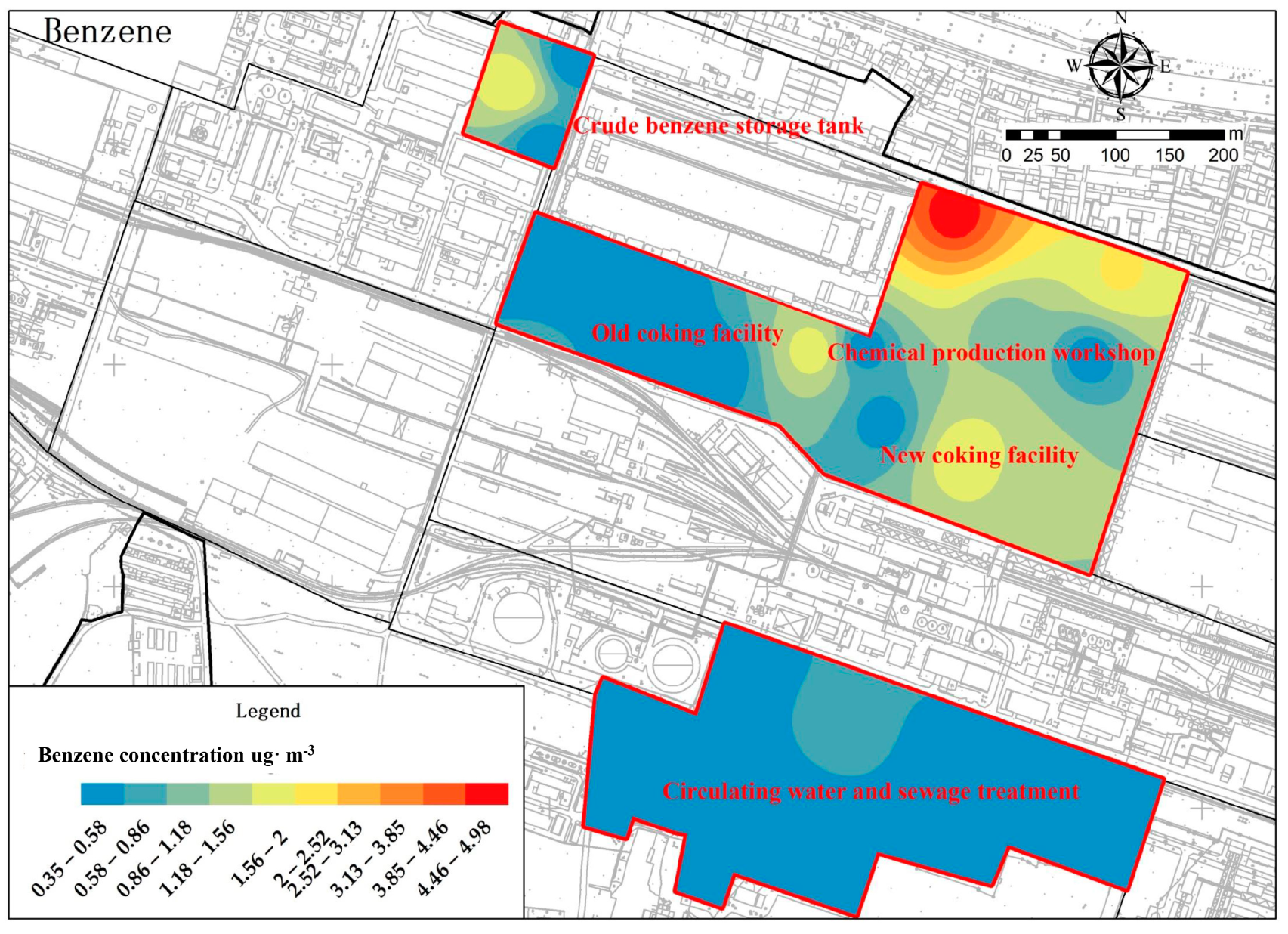




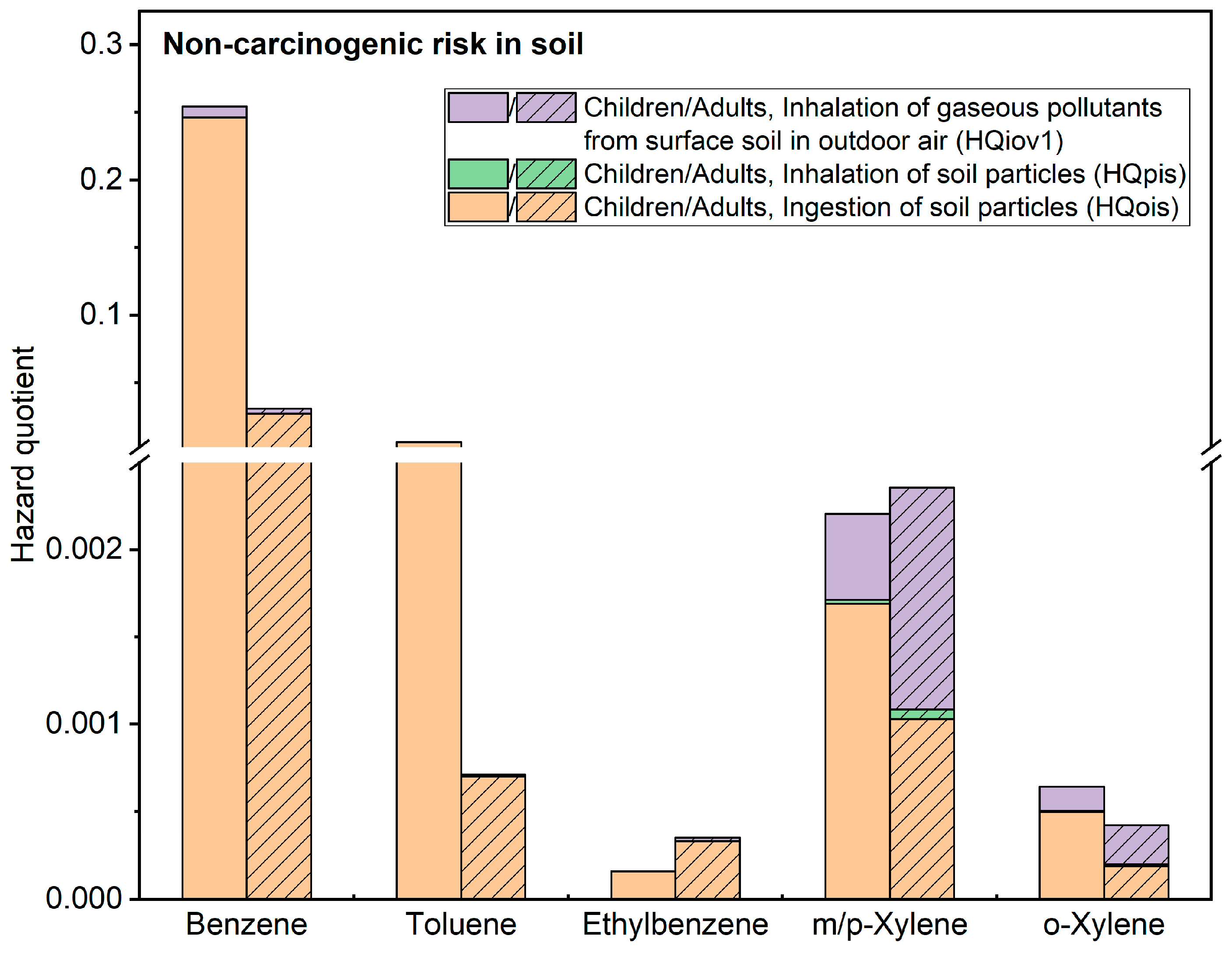

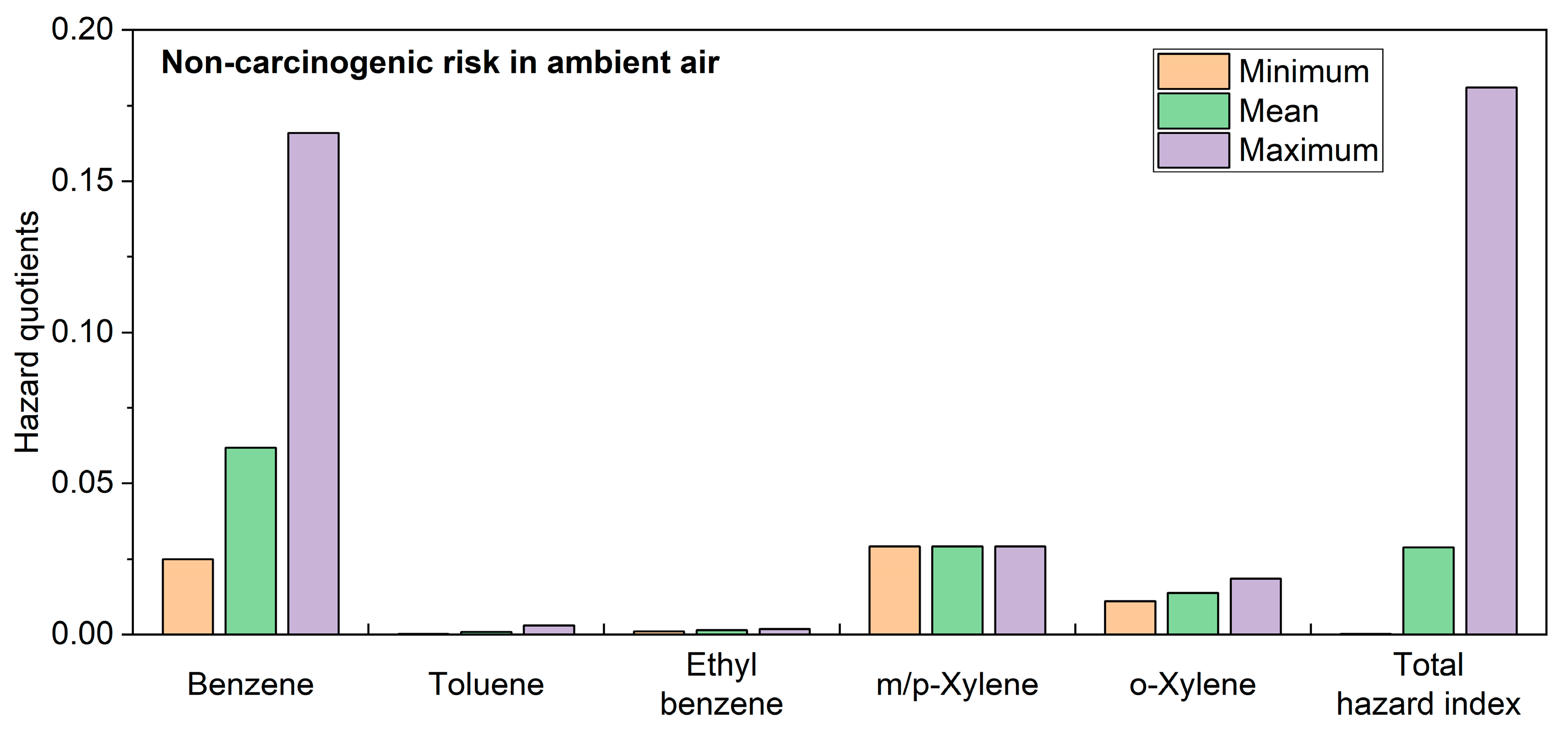
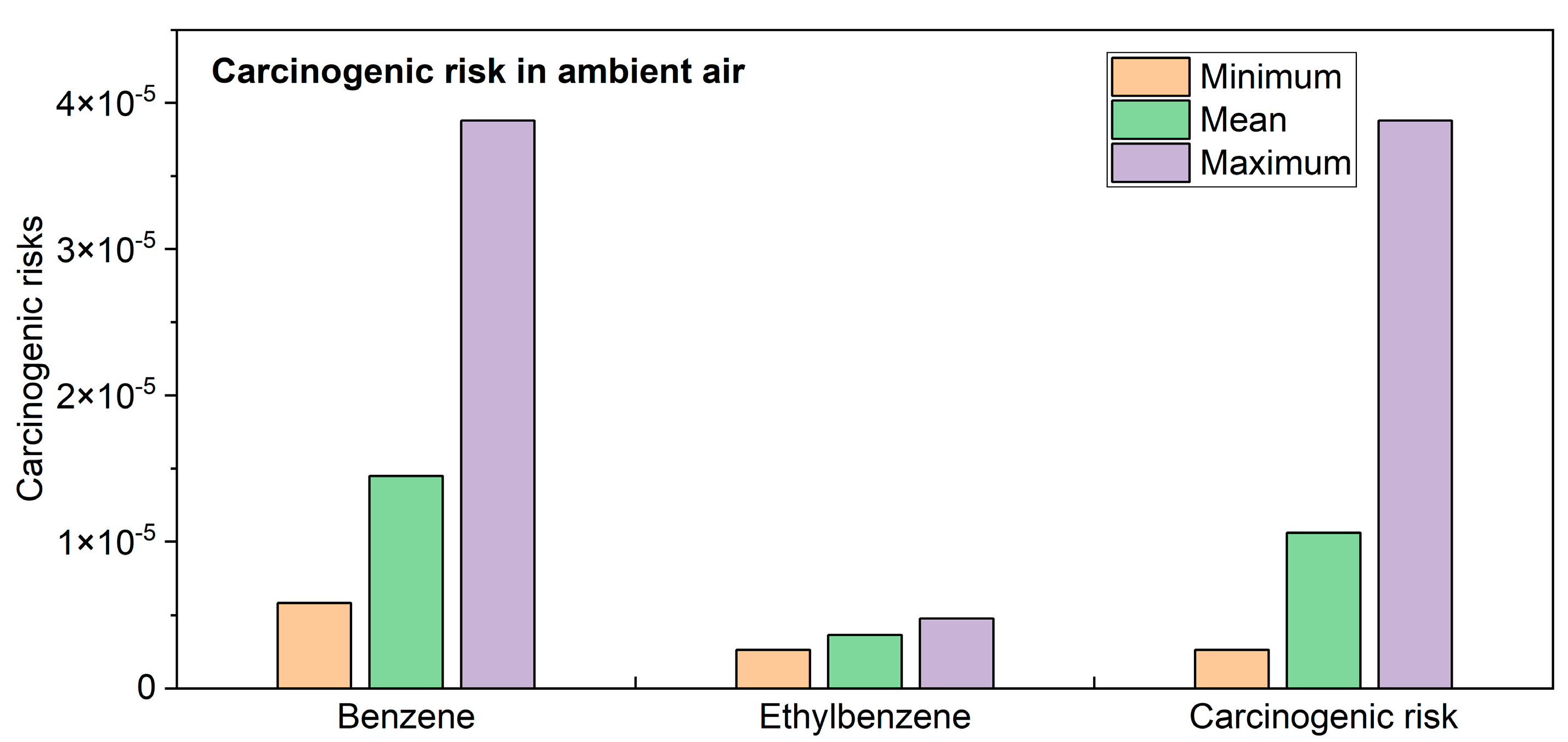
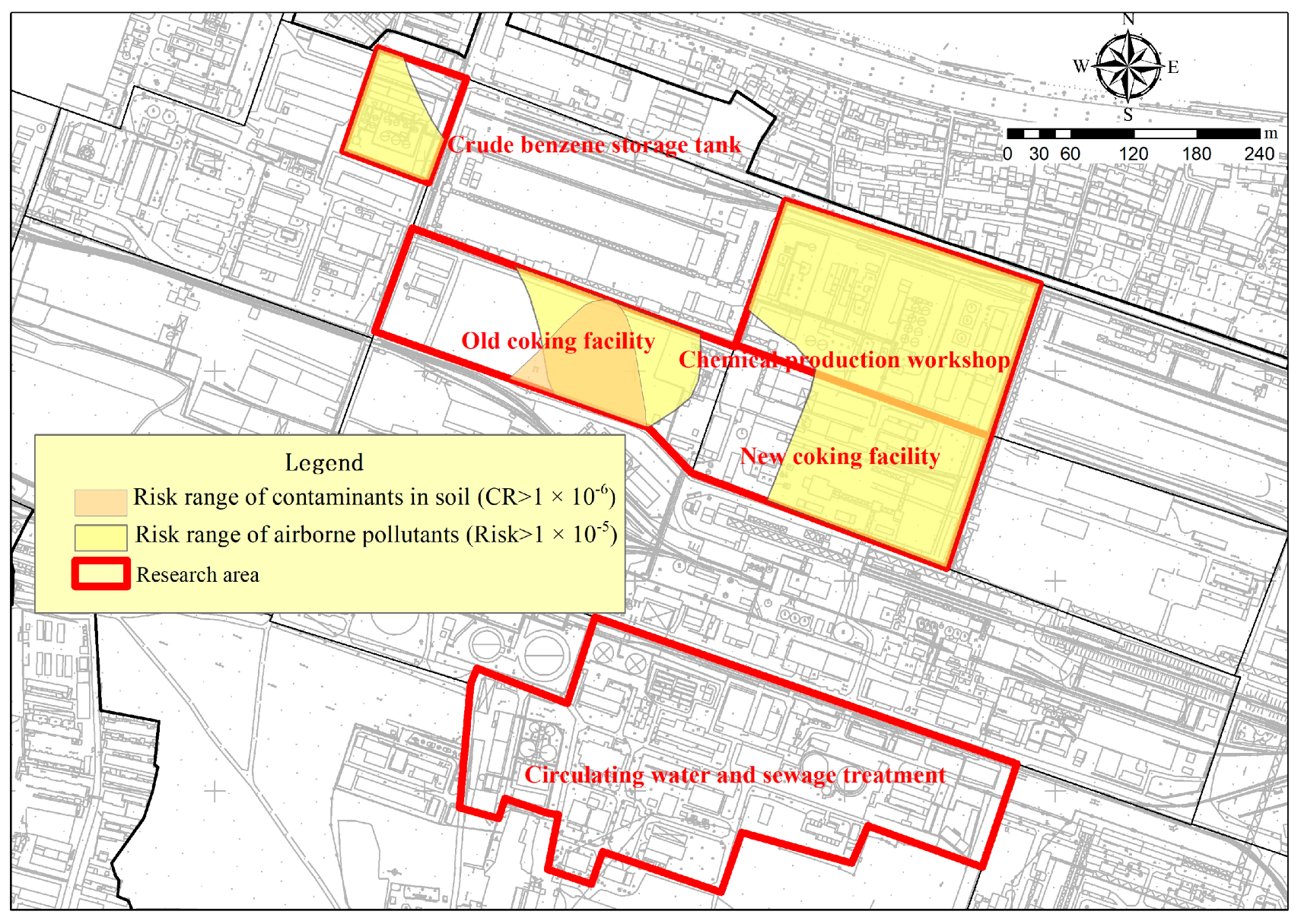
| Parameter | Parameter Name | Unit | Value |
|---|---|---|---|
| d | Thickness of contaminated topsoil layer | cm | 150 |
| fom | Soil organic matter content | g·kg−1 | 19 |
| ρb | Soil bulk density | kg·dm−3 | 1.64 |
| Pws | Soil moisture content | kg·kg−1 | 0.223 |
| ρs | Soil particle density | kg·dm−3 | 2.7 |
| PM10 | Concentration of inhalable particulate matter in the air | mg·m−3 | 0.08 |
| Pollutant Component | Minimum Value (mg·kg−1) | Average Value (mg·kg−1) | Maximum Value (mg·kg−1) | Detection Rate | Maximum Exceedance Multiple over Screening Value * | Proportion of Sites in Exceedance |
|---|---|---|---|---|---|---|
| Benzene | 0.0066 | 2.69 | 32.51 | 30.43% | 31.5 | 13.04% |
| Toluene | 0.0063 | 1.81 | 16.70 | 30.43% | - | - |
| Ethylbenzene | 0.0077 | 3.39 | 9.84 | 13.04% | - | - |
| m/p-xylene | 0.0104 | 14.11 | 61.50 | 21.74% | - | - |
| o-xylene | 0.0183 | 4.79 | 11.20 | 13.04% | - | - |
| Pollutant Component | Limit of Detection | Minimum Value | Maximum Value | Average Value | Standard Deviation | Number of Detections | Detection Rate | Contribution Rate |
|---|---|---|---|---|---|---|---|---|
| Benzene | 0.7 | 0.75 | 4.98 | 1.86 | 1.30 | 9 | 39.13% | 11.50% |
| Toluene | 0.82 | 1.04 | 15.1 | 4.59 | 3.67 | 23 | 100.00% | 72.58% |
| Ethylbenzene | 0.95 | 1.05 | 1.91 | 1.47 | 0.27 | 11 | 47.83% | 11.09% |
| m/p-xylene | 0.95 | 2.92 | 2.92 | 2.92 | - | 1 | 4.35% | 2.01% |
| o-xylene | 0.95 | 1.1 | 1.86 | 1.37 | 0.43 | 3 | 13.04% | 2.82% |
| Pollutants Concerned | Correlation Coefficient | Significance (Two-Tailed) |
|---|---|---|
| Benzene | −0.554 * | 0.04 |
| Toluene | −0.111 | 0.606 |
| Ethylbenzene | −0.809 ** | 0 |
| m/p-xylene | −0.577 | 0.134 |
| o-xylene | −0.839 ** | 0.009 |
| Sampling Point No. | Research Area | Benzene | Ethylbenzene | o-Xylene | |||
|---|---|---|---|---|---|---|---|
| FE (Dimensionless) | N (1 × 10−7 mol·h−1) | FE (Dimensionless) | N (1 × 10−7 mol·h−1) | FE (Dimensionless) | N (1 × 10−7 mol·h−1) | ||
| AS01 | Coking Area | 1.80 | 940 | ||||
| AS02 | 0.38 | 32 | 0.23 | 11 | 0.21 | 10 | |
| AS03 | 0.38 | 15 | |||||
| AS04 | 4.46 | 115,907 | 3.56 | 14,736 | 4.53 | 136,602 | |
| AS05 | 1.48 | 635 | 1.22 | 165 | 2.00 | 396 | |
| AS07 | 5.37 | 950,623 | 3.47 | 11,847 | 4.24 | 70,287 | |
| AS08 | 0.36 | 14 | |||||
| AS09 | 0.80 | 46 | 0.24 | 11 | |||
| AS10 | Chemical Production Workshop | 0.36 | 54 | ||||
| AS11 | −0.02 | −5 | 0.38 | 26 | 0.44 | 29 | |
| AS12 | 1.38 | 410 | 0.25 | 20 | |||
| AS13 | 1.73 | 378 | |||||
| AS14 | Crude Benzene Storage Area | 2.28 | 30,500 | 0.29 | 83 | 0.42 | 107 |
| AS16 | 0.20 | 63 | |||||
| AS19 | Circulating Water and Sewage Treatment Area | 2.20 | 1222 | ||||
| AS22 | 1.94 | 11 | |||||
| AS23 | 3.86 | 24,688 | 4.27 | 141,234 | 4.67 | 161,213 | |
Disclaimer/Publisher’s Note: The statements, opinions and data contained in all publications are solely those of the individual author(s) and contributor(s) and not of MDPI and/or the editor(s). MDPI and/or the editor(s) disclaim responsibility for any injury to people or property resulting from any ideas, methods, instructions or products referred to in the content. |
© 2023 by the authors. Licensee MDPI, Basel, Switzerland. This article is an open access article distributed under the terms and conditions of the Creative Commons Attribution (CC BY) license (https://creativecommons.org/licenses/by/4.0/).
Share and Cite
Li, X.; Xie, W.; Ding, D.; Wang, M.; Kong, L.; Jiang, D.; Deng, S. An Analysis of the Spatial Characteristics and Transport Fluxes of BTEX in Soil and Atmospheric Phases at a Decommissioned Steel Mill Site in China with a Long History. Toxics 2023, 11, 868. https://doi.org/10.3390/toxics11100868
Li X, Xie W, Ding D, Wang M, Kong L, Jiang D, Deng S. An Analysis of the Spatial Characteristics and Transport Fluxes of BTEX in Soil and Atmospheric Phases at a Decommissioned Steel Mill Site in China with a Long History. Toxics. 2023; 11(10):868. https://doi.org/10.3390/toxics11100868
Chicago/Turabian StyleLi, Xuwei, Wenyi Xie, Da Ding, Mengjie Wang, Lingya Kong, Dengdeng Jiang, and Shaopo Deng. 2023. "An Analysis of the Spatial Characteristics and Transport Fluxes of BTEX in Soil and Atmospheric Phases at a Decommissioned Steel Mill Site in China with a Long History" Toxics 11, no. 10: 868. https://doi.org/10.3390/toxics11100868
APA StyleLi, X., Xie, W., Ding, D., Wang, M., Kong, L., Jiang, D., & Deng, S. (2023). An Analysis of the Spatial Characteristics and Transport Fluxes of BTEX in Soil and Atmospheric Phases at a Decommissioned Steel Mill Site in China with a Long History. Toxics, 11(10), 868. https://doi.org/10.3390/toxics11100868









